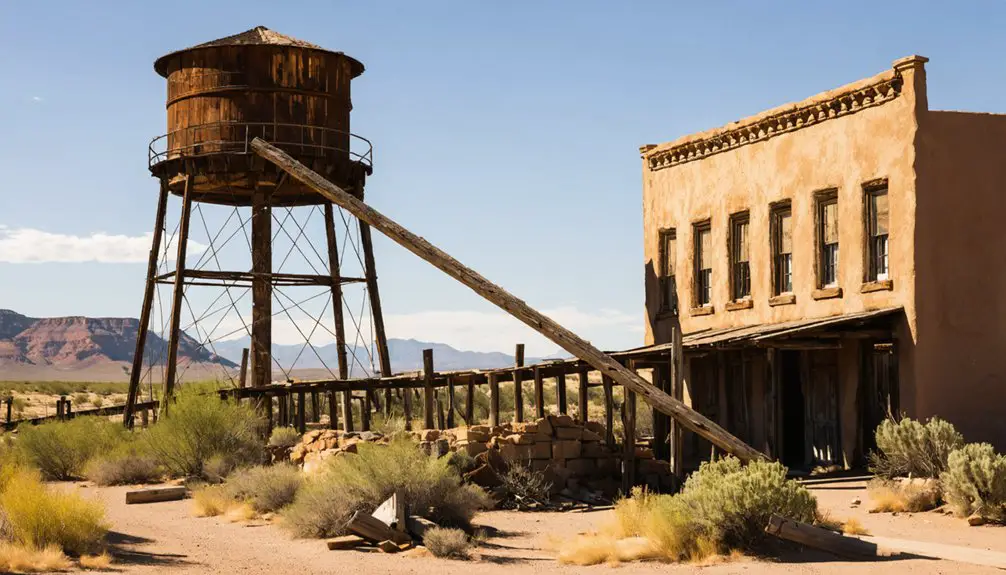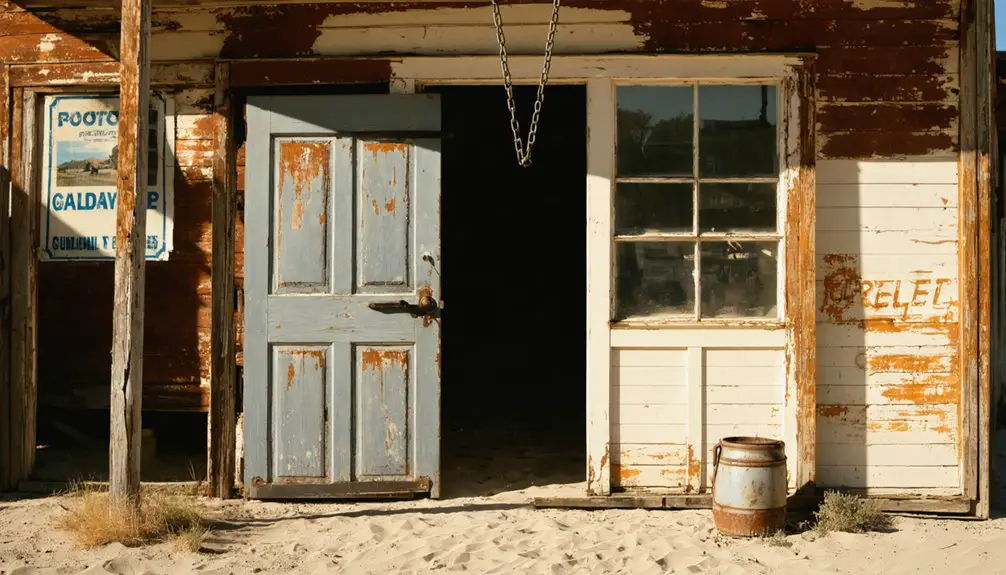You’ll find Castleton’s abandoned ruins at the edge of Castle Valley in southeastern Utah, where gold discoveries in 1888 transformed this frontier outpost into a bustling mining town. The settlement boasted saloons, shops, and a thriving general store that rivaled nearby Moab’s commerce. Though the Panic of 1907 triggered its decline, and by 1967 it stood abandoned, Castleton’s 5-acre site still holds fascinating remnants of its frontier legacy beneath the desert sky.
Key Takeaways
- Castleton was established in the 1880s as a mining town near Castle Valley, Utah, experiencing rapid growth after gold discovery in 1888.
- The ghost town is located at 38.343°N, -109.666°W, approximately 10 miles from Highway 128, requiring 4WD vehicles for access.
- At its peak in 1895, Castleton had saloons, shops, a general store, and a population rivaling nearby Moab.
- The town declined after the Panic of 1907, with only six residents by 1930, and was completely abandoned by 1967.
- Today, Castleton’s 5-acre site contains ruins managed by the Bureau of Land Management, preserving its frontier history.
The Rise of a Mining Settlement
While prospectors had frequented Castle Valley since the 1860s, Castleton’s formal establishment began when Doby Brown settled the area in the early 1880s.
You’ll find the town’s roots deeply intertwined with the region’s mining potential, as settlement challenges didn’t deter early pioneers from establishing a post office by 1882.
The real transformation came in 1888 when miners discovered gold in quartz at Miner’s Basin in the La Sal Mountains.
This discovery sparked mining innovations and turned what was once a simple camp into a bustling supply hub. The town grew rapidly to include essential frontier services including a general store, hotel, and several saloons.
Despite the difficult terrain and challenging transportation routes through rocky canyons, Castleton quickly grew into a crucial center that served both miners and ranchers. The town ultimately met its end when mines closed in 1907, leading to rapid population decline.
Life in a Booming Frontier Town
If you’d visited Castleton during its peak years before 1907, you’d have found a bustling frontier town with two lively saloons, multiple shops, and a thriving general store run by the Miller family.
You could’ve purchased supplies at Miller’s store, mailed letters at the post office, or found lodging at the local hotel while freight wagons rolled through town bringing goods from Salt Lake City.
The town’s population rivaled nearby Moab’s, as miners, ranchers, and cowboys created a diverse community complete with a Sunday school and law enforcement presence. Like many places requiring clarification, place name disambiguation helps visitors distinguish this Castleton from others in different regions. Community members gathered for special occasions, with Fourth of July celebrations being particularly memorable events.
Daily Mining Town Life
Life in Castleton during its mining heyday bustled with activity centered around Charles Edward Miller’s general store, where residents could purchase essential dry goods and supplies.
Daily routines revolved around mining operations in the nearby La Sal Mountains, with miners heading to the gold and silver mines while ranchers tended their cattle and sheep in the surrounding valleys. Similar to nearby Miner’s Basin, supplies would be hauled up the steep mountain paths to support the mining community. The community faced a major disruption when the financial panic of 1907 forced many residents to evacuate.
You’d find the town’s post office buzzing as mail carriers braved rugged terrain to deliver correspondence, sometimes relying on mules or young boys to reach remote mining camps.
Community gatherings often took place at the local saloon, hotel, or Sunday school.
When you needed services, you’d find them at the blacksmith shop, livery stables, cobbler, or doctor’s office – all essential parts of this frontier town’s infrastructure.
Peak Prosperity Years
During the height of Castleton’s prosperity in 1895, you’d find a bustling frontier town that surpassed nearby Moab in population and importance, driven by the gold rush in the La Sal Mountains.
The town’s community dynamics centered around Charles Edward Miller’s general store and post office, while “Plug Hat” Kelly’s saloon and a competing establishment provided entertainment for miners and ranchers alike.
As a reflection of the town’s prominence, you’d discover a complete infrastructure serving its peak population: a hotel, blacksmith shop, cobbler shops, livery stables, and a doctor’s office.
The mix of miners, ranchers, and sheepherders created a diverse frontier society, with families settled enough to support a school and Sunday services.
This prosperity positioned Castleton to vie for county seat status when Grand County organized in 1890.
Economic Growth and Development
While Castleton’s economic foundation began modestly with placer gold prospecting in the 1860s, the town’s rapid transformation into a thriving commercial hub occurred after the 1888 discovery of gold quartz in Miner’s Basin.
You’d have found a bustling community showcasing remarkable economic diversification, from freight services and general stores to hotels and restaurants. Similar to Eureka’s impressive two billion tons of mineral production, Castleton’s mining operations drove significant regional growth. The town’s community resilience was evident in how it balanced mining operations with sustainable ranching activities for both cattle and sheep.
During peak prosperity around 1895, Castleton even outgrew nearby Moab, boasting multiple saloons, blacksmith shops, and cobbler services.
The town served as an essential supply point for the La Sal Mountains mining operations, with Charles Edward Miller’s general store becoming a cornerstone of local commerce by 1902.
Geographic Location and Accessibility
Nestled at the foot of Utah’s La Sal Mountains, Castleton’s remote location presents unique challenges for modern-day visitors.
You’ll find this ghost town near Castle Valley, approximately 10 miles southeast of the State Highway 128 turnoff, at coordinates 38.343°N, -109.666°W.
The remote terrain demands careful planning if you’re heading to Castleton. You’ll need to navigate unmarked dirt roads that branch off Highway 128, and travel challenges include potential washouts and rough conditions that require high-clearance vehicles or 4WD. Similar to the monolith explorers who found no cell service in the Utah desert, visitors here will be completely disconnected from communications.
Don’t expect cell service or basic amenities – you’re truly off the grid here. The site lies within Grand County’s rugged Colorado Plateau region, surrounded by desert foothills and mesas. This area once served as a crucial mining supply center for the surrounding region.
Pack essential supplies and bring detailed maps, as signage is minimal in this isolated corner of southeastern Utah.
Notable Buildings and Infrastructure

The rugged remoteness that made Castleton challenging to reach also shaped its infrastructure needs, leading to a remarkable collection of buildings that served the mining community.
You’d find commercial structures clustered around the Millers’ general store and post office, which formed the town’s central hub. The hotel and two saloons, including “Plug Hat” Kelly’s establishment, provided necessary lodging and entertainment for weary miners.
Mining facilities dotted the landscape, with management offices and support buildings dedicated to gold, silver, and copper operations.
The town’s essential services included a blacksmith shop, livery stable, and freight company depots. Community life centered around a schoolhouse and Sunday school building, while several homes housed the town’s permanent residents.
The Final Days and Historic Legacy
Once prosperous and bustling with miners, Castleton’s fate was sealed by the Panic of 1907, which triggered a devastating chain of mine closures throughout Miner’s Basin.
You’ll find that community dynamics shifted dramatically as the population plummeted from its 1895 peak to just six residents by 1930. The once-thriving freight companies and supply services vanished, leaving only Charles Edward Miller’s general store and post office to serve the dwindling population.
Today, Castleton stands as a monument to the boom-and-bust cycles of the American West. The Bureau of Land Management has explored cultural preservation efforts at the 5-acre site, where ruins tell the story of frontier life.
While officially abandoned in 1967, Castleton’s legacy lives on through museum archives and oral histories of mining and ranching life.
Frequently Asked Questions
What Happened to the Original Structures and Mining Equipment After Abandonment?
You’ll find most abandoned structures deteriorated or disappeared naturally, while others were scavenged for materials. Mining equipment was either salvaged for reuse elsewhere or removed by relic hunters over time.
Were There Any Significant Conflicts Between Miners and Native Americans?
Dramatic disputes during the Black Hawk War (1865-1872) shaped miner-native relations near you’ll find Castleton, where Ute warriors led raids against settlers while defending their ancestral lands and resources.
How Did Residents Handle Medical Emergencies in Such a Remote Location?
You’d rely on basic first aid skills, home remedies, and neighbor support. During emergencies, you’d face difficult emergency transport by horse-drawn wagons over rough terrain to reach doctors in Moab.
What Were the Typical Wages for Miners in Castleton During Peak Operations?
You’d have earned between $3-$4 per day as a miner, translating to roughly $500 annually. Mining wages were considered good, though economic conditions often led to payment delays and company store deductions.
Did Any Paranormal Activity Reports Emerge From the Abandoned Town Site?
Still waters run deep, but you won’t find documented ghost sightings or eerie sounds here. Unlike other Utah ghost towns with rich paranormal folklore, Castleton’s abandoned site hasn’t yielded any verified supernatural reports.
References
- https://www.moabhappenings.com/Archives/historic1009GhostTownRuins.htm
- https://moabsunnews.com/2022/04/28/the-ghost-town-of-castleton-utah/
- https://en.wikipedia.org/wiki/Castleton
- https://moabmuseum.org/moab-history-daily-life-in-castleton-utah/
- https://jacobbarlow.com/2016/04/08/castleton-utah/
- https://www.moabhappenings.com/Archives/pioneer0310.htm
- https://ogm.utah.gov/wp-content/uploads/2023/09/Castletonfinal.pdf
- https://utahstories.com/2023/11/ghost-towns-of-grand-county-utah/
- https://www.cityweekly.net/utah/buried-treasures/Content?oid=21984514
- https://www.youtube.com/watch?v=U63zicCAQIk



